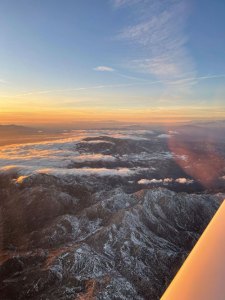
By Natalie Miles, EAA 1478672
The instrument rating tends to be one of the most challenging times in one’s training. New information, more regulations, cross-check/scanning techniques, multi-tasking, radio communications, and programming avionics is a significant amount of knowledge and skills to acquire in such a short period of time. The most important thing I have learned is to trust in my training. Six months ago, I could not have told you what ailerons are. I did not understand aerodynamics. I did not know what caused the weather. I did not know what a stall was. But, here I am today with an array of knowledge and capability to fly an aircraft legally and safely. Do not get caught up in the unknown. As time goes by, you will gain proficiency. A good pilot is one that is always willing and able to learn.
My instrument training started out with a few sims and a few flights. Working on standard rate turns, basic attitude and instrument flying, and the most difficult task of all … wearing the FOGGLES. For those of you who do not know what foggles are, lucky you. Foggles are similar to safety glasses worn to simulate instrument meteorological conditions. They block the outside view so the pilot is only able to visually see the avionics in front of them. This helps train the pilot to become comfortable with solely referencing the instruments if, for example, you were flying through a cloud and were not able to identify the ground. After completing the first stage of instrument training I moved on to holds, arcs, STARs, and DPs. The real knowledge of instrument flying had officially begun. This stage of my training was completed in the simulator. After understanding intersection holds, DME arcs, ODPs, and SIDs, I was finally able to step back into the Cirrus. I sure missed having the privilege to fly, but the night schedule was not the most fun.
 I completed my 250 nm cross country with a flight from Goodyear (KGYR) to Carlsbad (KCRQ), Montgomery (KMYF), Yuma (KNYL), and back to Goodyear. It was my first time flying over the Pacific Ocean! Flying through California was exhilarating. Unfamiliar areas, new terrain, busy airspace, and clouds. Arizona has beautiful weather to fly in, but with all the blue skies, it is not the best place to fly for instrument training. My flight to California was the first time I flew through a cloud. I felt on top of the world. All those times you sit on a commercial flight, look out the window, climb above the clouds, and immediately pull out your phone to take a picture. I was living that memory, but this time, I was the one flying.
I completed my 250 nm cross country with a flight from Goodyear (KGYR) to Carlsbad (KCRQ), Montgomery (KMYF), Yuma (KNYL), and back to Goodyear. It was my first time flying over the Pacific Ocean! Flying through California was exhilarating. Unfamiliar areas, new terrain, busy airspace, and clouds. Arizona has beautiful weather to fly in, but with all the blue skies, it is not the best place to fly for instrument training. My flight to California was the first time I flew through a cloud. I felt on top of the world. All those times you sit on a commercial flight, look out the window, climb above the clouds, and immediately pull out your phone to take a picture. I was living that memory, but this time, I was the one flying.
Once my cross country was completed, it was back to perfecting my instrument skills. I am currently refreshing and polishing my IAP (instrument approach procedures). I am flying ILS, VOR, RNAV, etc. approaches into airports to prepare for my checkride. Instrument training is undoubtedly difficult, but it truly is the “bread and butter” of airline flying.
Natalie Miles, EAA 1478672, is currently pursuing her aviation dreams at the United Aviate Academy, and will be updating her progress on a regular basis as a scholarship student in the flight training program. Natalie received a joint scholarship at The Gathering 2022 from the EAA Aviation Foundation and United Aviate Academy. United Aviate is a major supporter and sponsor of the AeroEducate program.
